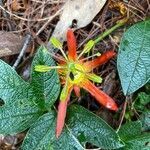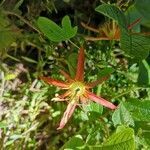Perennial climber to c. 4 m long, with simple axillary tendrils, glabrous. Stem terete, slender. Stipules linear-subulate, (1–) 3–8 mm long, curved. Leaves alternate, 3-lobed for c. ⅓–⅔ of length; lobes broadest about midway, especially middle one, obtuse to acute, each with a single main vein, sometimes in younger foliage sublobing apparent; lamina (2–) 4–7 (–12) cm long, (2–) 6–8 (–13) cm wide, without glands or with 2–6 small glands scattered on either side of midvein, base truncate to cordate; margin entire; petiole (1–) 2–4 (–6) cm long, without glands. Flowers bisexual, borne singly in leaf axils, 4–7 cm diam.; pedicels (2–) 3–5 cm long; bracts 3, filiform, 6–12 mm long, c. 0.5 mm wide. Sepals red adaxially, greenish red abaxially, 20–35 mm long, keeled. Petals red, 8–15 mm long. Corona 2 closely aligned series of filaments, often appearing as one, yellow; outer series 8–15 mm long; inner series 4–7 mm long; operculum whitish, membranous, plicate, 5–6 (–8) mm long, upper margin fimbriate. Androgynophore 20–40 mm long, straight. Stamens 5. Styles 3. Fruit an ellipsoidal to spheroid berry, 2–4 cm long, 2–2.5 cm wide, green. Seeds reticulate.
More
A vigorous climber. The leaves are green and young growth is smooth. The stems are very long and slender and wiry. The leaves are about 10 cm long by 10 cm wide and have 3 lobes. They are dark green. The stalk is 2-5 cm long. The flowers are 6.5 cm across. They are bright red and occur singly in the axils of upper leaves. The fruit are 3.5 cm long by 2.5 cm wide. They are oval and green to grey.


